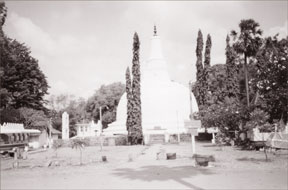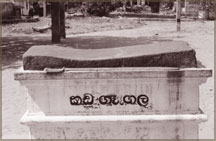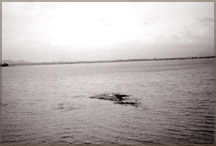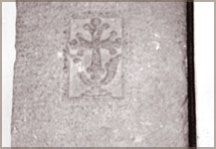The little ocean of Rajarata
by Supun Perera
Having an interest in taking a little journey to Anuradhapura, the
city where our heritage lies is some what fascinating. It is a privilege
of any traveller to visit this historic city and it's suburbs since it
reflects the glorious past of our tiny island.
|

Compound of the historic Vijithapura temple with the
renovated dagoba |
Among those in the sacred city of Anuradhapura, 'Kalawewa' needs
special mention. Roaming on the banks of Kalawewa paints a natural
picture which could be considered as one of the most gorgeous places one
could find in Sri Lanka. This reservoir belongs to the fourth century Ad
and the brainchild of King Dhatusena.
It provides irrigation to nearly 2500 acres of paddy fields by
dividing it in to two sectors, one as Kalawewa the right flank as 'Balalu
Wewa'.
|

‘Kadu Ge Gala’: the rock (Granite) where the swords and the
archery were supposed to be sharpened. |
The firm belief of the ancient kings of Sri Lanka was development of
this country based on agriculture. To fulfil this motive they realised
there has to be a sound irrigation system coupled with adequate
technology. The era of King Dhatusena could be termed as a precious era
as far as the cultivation and irrigation are concerned. He built
Kalawewa as the main irrigational reservoir and to divert it's water he
initiated 'Yoda Ela.'
However, this 'Little ocean' was in ruins for many centuries. It was
subsequently re-constructed by the British and brought back to it's
pristine glory in 1887.
Vijithapura temple
|

Kalawewa: The ‘Little Ocean’ in Rajarata |
It is just 2 km to the North of the Kalawewa. You find the remote
village of Vijithapura believed to be the exact place where King
Dutugemunu's force and King Elara's force battled for supremacy. Another
'school of thought' says that Vijithapura is located in Polonnaruwa,
which was the Medieval capital after Anuradhapura.
According to the village folk the temple belongs to the 2nd century
BC. The ruins of 'Pohoya Getya' 'Dana Sala' could be seen. The 'stupa'
in Vijithapura somewhat similar to Thuparama is renovated.
|

The Nestorian Cross: This was found in the sacred city of
Anuradhapura which is believed to be in the 6th century. |
What catches the eye of the visitors; the granite stone which was
supposed to be used to sharpen the swords in the famous Dutugemunu Elara
battle, according to history, is that there had been 500 to 1000
bhikkhus based in Vijithapura premises for meditation purposes during
the reign of King Devanampiyatissa.
The archaeological museum and the nestorian cross
The archaeological remains belong to the 2nd and third century BC
could be found in the museum which is located in the sacred city of
Anuradhapura. Some of these remains opens new vistas to Lankas Arts and
Aesthetic culture. The nestorian cross that was carved in a stone dated
to 6th century AD.
There is a belief that the Syrian catholics were in Sri Lanka during
this era for the trade purposes. However, history books reveal another
story where the cross belongs to 16th century AD which was the advent of
Portugese to the island. Therefore, it is believed to be a tomb stone. |
